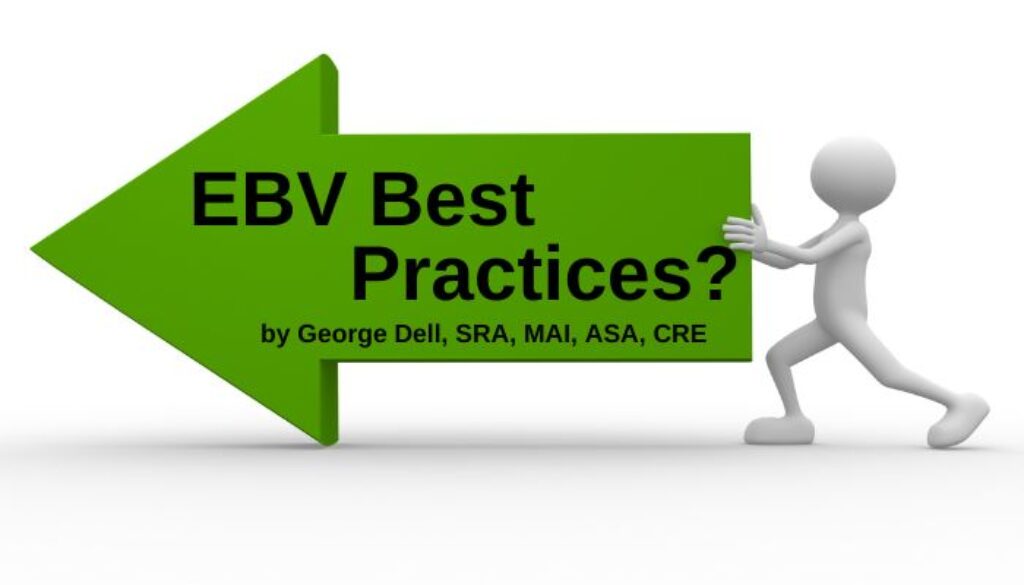The developers of EBV (Evidence Based Valuation©) have concluded that best practices are dependent on the needs of the client for reliability and useability of the results.
The need of the client is the predicted value (estimate). The goal of a valuation is trueness (accuracy) of the prediction or opinion. The test of any valuation is the sureness (precision) of the predicted value.
Editor’s Note: This is Standards, part 3.20 of George Dell’s series on How Do I Move to EBV? Links to the earlier posts are here.
Both trueness and sureness depend on the appropriate question – the correct assumed/directed scope of work needed to answer the question asked.
So what are the best practices to achieve the ideal sureness, trueness, and appropriateness?
User, clients require varying levels of sureness. This changes the nature of the question. For example, for a mortgage loan, a low loan-to-value ratio means a “ballpark” value is all that is needed. (Low cost, fast, but ‘compliant’.) On the other end, a litigation case with heavy ramifications could require a very high level of sureness, with detailed and incisive ‘support’ for the result.
So “best practice” depends heavily on the depth and detail of our components of asset assay:
- Scope of work, appropriateness, and correct hypothesis;
- Data: Completeness and relevance of the data (as available and necessary);
- Analysis: Modeling with the best paradigm, using ‘adjustments’ or predictive methods;
- Communication: via static or dynamic visual/numerical dashboard design.
New standards of practice are needed to match today’s process technology. Process technology considers the models, algorithms, software, and interface for analysts. (Product technology is more akin to hardware, databases, and ‘cloud’ connectivity.)
Current re-emphasis on the need for unbiasedness and ethical behavior may do little to change actual behavior. It may even distract from real solutions.
Personal bias, whether conscious, unconscious, or “accidental” can only happen when the underlying process or system allows the prejudicial act.
Today’s (legacy) appraisal standards, practices, and enforcement enable bias. The USPAP test of an adequate scope of work is that the appraisal is acceptable to the user, and that it mimics what appraiser ‘peers’ do. Current practices expect the appraiser to ‘pick’ some comps, then narrow differences with ‘adjustments’ as support for a point-value opinion.
Any new, anti-bias “best practices” should reflect current process technologies. These comprise:
- The cloud availability of complete or near-complete data in most areas;
- Use of data science “similarity matching” models and algorithms;
- Measurable, reproducible assessment, and tests of reliability;
- Transparent quality visualization and dashboard delivery.
Adaptable best practices engage the above four elements. Each of these elements can flex to the risk level involved in each client’s need – whether collateral, investment, or equity purposes.
EBV© is available at no cost to appraisers, including the software. It does require the acquisition of modern methods at a cost no greater than the hours currently required for licensing continuing education. Available from Valuemetrics.info, supportive of the CAA© (Community of Asset Analysts). This weekly blog is available at georgedell.com.

December 6, 2023 @ 9:40 am
It’s about time that you used the term “Estimate” for the predictive value of a property instead of the term “Opinion” which anyone could have. Numbers and money are involved in appraisal so the predictive value must always be Estimate.
Steven Davis MRICS
December 11, 2023 @ 8:46 am
Is prediction the objective? Prediction of what? Prediction of a hypothetical purchase price that doesn’t involve the greedy seller and gullible buyer that are actually involved in the transaction? And how often do we find appraisers and others implying that appraisal is normative, not predictive, with statements like “the current market is overheated and prices are too high” or something similar?
The idea that lower accuracy or precision are OK for a lower LTV or loan amount is not found in USPAP, or appraisal guidance from regulators or clients. It makes sense, and is surely a factor in the growing use of AVMs and evaluations. But nowhere in the voluminous USPAP or regs is the term “ballpark.”